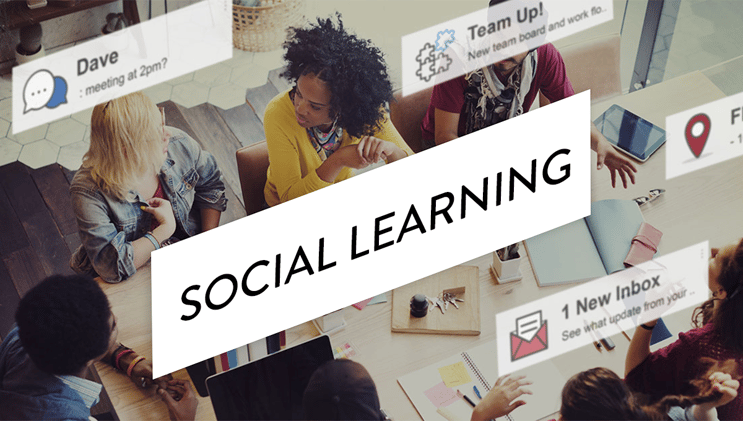
Social learning is at the forefront of workforce development discussions right now. It may feel like a new phenomenon, but it is as ancient as learning. The knowledge that people gain outside formal training has always existed whether we noticed or not.
The difference between then and now is that we want to leverage informal learning to improve performance instead of just letting it happen. We want to make its benefits visible.
What is Social Learning?
Social learning is not any one thing. We use dozens of terms to define it, but they come down to learning from one another as we connect, converse, and collaborate with each other. It doesn’t matter if you call it social networks, informal learning, communities of practice, or anything else. It is what we learn as we work together.
Another way to describe social learning is by the way it happens.
- Tribal knowledge is the knowledge contained in our groups: business functions, work teams, project team, job families, or any other permanent or temporary group. Humans are tribal beings, and our tribal memberships fluctuate over the course of a day as we interact with various groups of people. People create tribal knowledge and passed it on as they work together.[1]
- Tacit knowledge is what we know and find difficult to communicate Leadership, innovation, and intuition are good examples. It can be described as what everybody knows but can’t explain. Tacit knowledge in your organization can be a competitive advantage because your competitors can’t duplicate it.[2]
- Conversational learning happens when people have talked about what they know or don’t know, or about a problem they are trying to solve.
- Social knowledge is available to anyone in a social or cultural context. Unlike the insider information in tribal culture, it is freely available to anyone.
How do we measure transfer of knowledge?
One way we can measure informal learning is through the technology we use to enable it. Many solutions are available today. We have enterprise collaboration tools like Slack, Jabber, HipChat, and Vibe. LMS vendors are integrating collaboration tools into their platforms, and we have established content sharing platforms such as SharePoint and Box.
We can use embedded analytics in these tools to answer these questions:
- Who takes part and how much (and who doesn’t)?
- Who shares knowledge and resources?
- Is the number of participants growing?
- What percentage of users are active?
- What activities do they participate in?
- Who seeks new knowledge sources and how much?
These kinds of measures help us understand adoption, enthusiasm, and satisfaction levels, but we need to measure on other factors also. To measure whether learning is taking place and whether it is improving performance, assessments and surveys delivered through the collaboration tools can capture the information we need. If you make the surveys short and user-friendly enough, you can gauge what is happening.
Measuring Impact
Measuring impact is harder than collecting data on events. Surveys and assessments can help gather information about individual or team work or team performance, but your business leaders are interested in organizational performance. This is where we need to move from an internal focus to discuss the concerns of stakeholders.
Measuring the impact of social learning on the organization requires alignment of objectives to organization strategy and goals. To set the stage, you will need to work with your business leaders:
- identify the KPIs you want to influence,
- determine what metrics you will use,
- agree on the expected percentage of influence the learning will have on the outcomes,
- use data to correlate social enterprise learning behaviors with organizational performance metrics,
- control for other factors that may have influenced the outcome, and
- calculate the business impact.
Not controlling social learning doesn’t mean it needs to be out of control. Business leaders, L&D, and other influencers will set the direction by the way they use the tools and what information they share. The most important factor is your organizational culture, but that doesn’t mean you need to transform your culture before you start. You can use the tools as an integral part of your planned cultural change.
Social learning tools can improve your organization. Seize this opportunity to create a learning culture.
References:
2. Spacey, John. "10 Examples of Tacit Knowledge." Simplicable. June 27, 2016. Accessed November 2016.
Pixentia is a full-service technology company dedicated to helping clients solve business problems, improve the capability of their people, and achieve better results.

